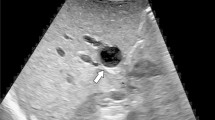Abstract
We report on two infants with biliary atresia who underwent a successful Kasai operation at the age of 125 and 109 days, respectively. These cases support the hypothesis that in some cases the biliary tract may be normal or near-normal at birth, but secondary changes may later lead to an abnormality. Under such circumstances the prognosis is influenced by the length of time since the onset of biliary tract obstruction, and not by the absolute age of the patient. This implies that the Kasai operation should still be considered after the age of 100 days of life.
Similar content being viewed by others
References
Bangaru B, Morecki R, Glaser JH, et al (1980) Comparative studies of biliary atresia in human newborn and reovirus induced cholangitis in weaning mice. Lab Invest 43: 456–462
Bielamowocz A, Weitzman JJ, Alshak NS et al (1992) Successful late Kasai portoenterostomy. J Pediatr Gastroenterol Nutr 14: 232–236
Desmet VJ (1987) Cholangitis: past, present and future. Semin Liver Dis 7: 67–72
Landing BH (1974) Considerations of the pathogenesis of neonatal hepatitis, biliary atresia and choledochal cyst: the concept of infantile obstructive cholangiopathy. Prog Pediatr Surg 6: 113–139
Mieli-Vergani G, Howard ER, Portman B, et al (1989) Late referral for biliary atresia — missed opportunities for effective surgery. Lancet 1: 421–423
Nakajo T, Hashizume K, Saeki M, et al (1990) Intussusception-type antireflux valve in the Roux-en-Y loop to prevent ascending cholangitis after hepatic portojejunostomy. J Pediatr Surg 25: 311–314
National Institutes of Health Consensus Development Conference Statement (1984) Liver transplantation, June 20–23, 1983. Hepatology 4: 1078–1105
Ohi R, Ibrahim M (1992) Biliary atresia. Semi Pediatr Surg 1: 115–124
Oppenheimer EH, Esterly JR (1973) Cytomegalovirus: a possible cause of biliary atresia. Am J Path 71: 22
Schreiber RA, Kleinman RE (1993) Genetics, immunology, and biliary atresia: an opening or a diversion? J Pediatr Gastroenterol Nutr 16: 111–113
Silveria TR, Salzano FM, Donaldson PT, et al (1993) Association between HLA and extrahepatic biliary atresia. J Pediatr Gastroenterol Nutr 16: 114–117
Strauss L, Bernstein L (1968) Neonatal hepatitis in congenital rubella: a histopathological st study. Arch Pathol 86: 317–327
Weaver LT, Nelson R, Bell TM (1984) The association of extrahepatic bile duct atresia and neonatal Epstein-Barr virus infection. Acta Pediatr Scand 73: 155–157
Witzleben CL (1976) Etiology(ies) of infantile obstructive cholangiopathy. J Pediatr 88: 901–910
Author information
Authors and Affiliations
Rights and permissions
About this article
Cite this article
Suita, S., Arima, T., Kubota, M. et al. Is age really critical when performing portoenterostomy for biliary atresia?. Pediatr Surg Int 10, 48–50 (1995). https://doi.org/10.1007/BF00174444
Accepted:
Issue Date:
DOI: https://doi.org/10.1007/BF00174444




